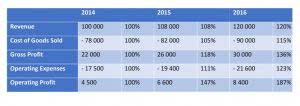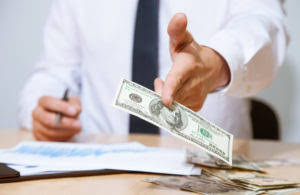Content
- How Can Ordinary Individuals Use Break-Even Prices?
- Calculating The Break-Even Point in Sales Dollars
- Examples of Break-Even Analysis
- How to Calculate the Break Even Point of Your Business
- Using break-even price to set a product’s price
- What is Break Even Pricing?
- Breakeven Selling Price
- Financial Ratios
Let’s imagine a trader buys a call option to buy Zoom Video Communications Inc at a strike price $140. The date is February 15th, and the contract is set to expire 31 days later on March 18th. Currently, ZM stock trades at $146.90, and the value of the option is priced at $17.49. A trader who purchases a call or a put benefits by knowing which factors influence the value of the option.
- As we will see through the two examples that follow, the payout of a long option strategy differs depending on whether the trader is long a call or a put.
- This means Sam’s team needs to sell $2727 worth of Sam’s Silly Soda in that month, to break even.
- Break-even sales considers a product’s sales price and its variable and fixed costs.
- Variable costs refer to the costs that change with the change in the level of output.
- If the difference between the additional revenue and additional cost is positive, then you accept the order.
- It is also helpful to note that sales price per unit minus variable cost per unit is the contribution margin per unit.
Also, such a strategy allows a firm to set the lowest acceptable price. Are you bringing in enough revenue to cover all of the expenses you need to pay? Are your products or services profitable, or are you selling yourself at a loss? The answer to these questions can mean the difference between surviving and thriving.
How Can Ordinary Individuals Use Break-Even Prices?
Instead of returning a BEP in units sold, this equation calculates the exact dollar amount your company would need to sell to break even. BlueCart is a comprehensive eCommerce software solution for wholesalers, small businesses, dropshippers, and hospitality establishments. We offer a complete set of tools including unlimited digital catalogs, shipping and delivery route management, integrated payment processing, and SEO-ready digital storefronts. Book a demo now to see how BlueCart can save you money and streamline processes today.
How does break-even point affect buying and selling?
A break-even analysis is a useful tool for determining at what point your company, or a new product or service, will be profitable. Put another way, it's a financial calculation used to determine the number of products or services you need to sell to at least cover your costs.
It helps the company to reduce the competition and dominate the market. A point to note is that the BEP formula includes the number of items that a company expects to sell. So, the real break-even price would be somewhat different from what the formula gives.
Calculating The Break-Even Point in Sales Dollars
Break-even sales considers a product’s sales price and its variable and fixed costs. Again, collecting information about the price of substitute goods can help businesses choose an appropriate sales price. It shows how the break-even price changes for different unit sales projections. If the business projects it will sell 20,000 units, then the break-even price is $3.58 per candle. Soy Candles LLC can use this information to set a price for its candles. To cover all of its fixed and variable costs, the price per unit would need to be at least $3.58 if the business sells 20,000 units.
However, after establishing market dominance, a business may begin to raise prices when weak competitors can no longer undermine its higher-pricing efforts. Break-even price is also used in managerial economics to determine the costs of scaling a product’s manufacturing capabilities. Typically, an increase in product manufacturing volumes translates to a decrease in break-even prices because costs are spread over more product quantity. A rate of return is calculated on the profits remaining after the initial outlay has been written off. The borrower receives merchandise, with the lender advancing anywhere from 80% to 100% of the cost. Documents include a list of each item along with its description and serial number.
Examples of Break-Even Analysis
Variable costs at $0.50 per unit, and you’re selling the app to consumers for $3.00. They’re set amounts that are due regularly, usually monthly, and usually only change when a contract is renegotiated or a planned annual increase occurs.
- However, after establishing market dominance, a business may begin to raise prices when weak competitors can no longer undermine its higher-pricing efforts.
- Furthermore, the fixed costs once established do not change over the life of the contract.
- Such a pricing strategy helps managers when preparing business and marketing plans and when entering a new market.
- We can also say that achieving economies of scale is one more objective of breakeven pricing.
- This is another vital piece of information to include in your break-even formula.
This method is most useful for those companies with sufficient resources to lower prices and fight off attempts by competitors to undercut them. It is a difficult approach for a smaller, resource-poor company that cannot survive for long with zero margins. A break-even price describes a change of value that corresponds to just covering one’s initial investment or cost. If mathematical formulas make you want to run away and hide, hold tight! It’s really not that scary, and given the essential nature of this formula, as it relates to your profit and loss statements, you’ll want to stay tuned. The break-even point or cost-volume-profit relationship can also be examined using graphs. If the same cost data are available as in the example on the algebraic method, then the contribution is the same (i.e., $16).
How to Calculate the Break Even Point of Your Business
Small Business Administration’s SBA break even calculator online, or another that you like. If you decide to use the NASE calculator, round the forecast unit sales number to the nearest thousand . As a variation of the breakeven formula, you can calculate your cash break even point, which assesses break even cash flow instead of including non-cash expenses like depreciation in the calculation.
Knowing exactly how much you can lose is just as important as how much you gain on a particular investment, so know your numbers. Designating that point, as in a commercial venture, at which income and expenses are equal.
Manufacturing businesses can reduce production costs by improving quality, thereby reducing material scrap and product rework. If their ERP system integrates with intelligent shop floor hardware and software, including IoT sensors, AI monitoring, and early problem alert notifications, variable product costs can also be cut.
In this article, we will discuss the breakeven formula and how to calculate the breakeven point. Thus, the breakeven point is a point where your business earns zero economic profit. However, it helps you to understand that you need to rise above this point to maximize economic profits. Sensitivity of break-even price to changes in annual projected unit sales. For this example, Soy Candles LLC projects it will sell 20,000 units next year. To learn how to prepare a breakeven analysis, check out this article on wikicfo. If you also want to learn how to price for profit, thendownload our Pricing for Profit Inspection Guide.
The following diagram illustrates the concepts related to the breakeven analysis. Variable Costs per Unit- Variable costs are costs directly tied to the production of a product, like labor hired to make that product, or materials used. Variable costs often fluctuate, and are typically a company’s https://personal-accounting.org/ largest expense. Typically, the first time you reach a break-even point means a positive turn for your business. When you break-even, you’re finally making enough to cover your operating costs. Break-even analysis gives you a much more solid basis from which to price your products.
These considerations shouldn’t stop you from going after the business of your dreams, but be sure to keep these caveats in mind when you’re performing a break-even analysis. Many or all of the products featured here are from our partners who compensate us. This may influence which products we write about and where and how the product appears on a page. Let’s begin with a very simple calculation of breakeven and build from there. (i.e., there is no change in the quantity of goods held in inventory at the beginning of the period and the quantity of goods held in inventory at the end of the period).
Using break-even price to set a product’s price
The lender generally uses a terminal warehouse when secured inventory is easily and cheaply transported to the warehouse. When goods arrive at the warehouse designated by the lender, the warehouse official “checks-in” the merchandise, listing each item on a warehouse receipt.
James Woodruff has been a management consultant to more than 1,000 small businesses. As a senior management consultant and owner, he used his technical expertise to conduct an analysis of a company’s operational, financial and business management issues. James has been writing business and finance related topics for work.chron, bizfluent.com, smallbusiness.chron.com and e-commerce websites since 2007. He graduated from Georgia Tech with a Bachelor of Mechanical Engineering and received an MBA from Columbia University. Once a company sets a price lower than the competitors to gain market share, it becomes difficult to raise the price later.
There’s a significant financial buy-in up top, and you need to take risks if you want to make money. But when you’re down on your luck in gambling or business, the short-term goal may simply be to break even.
This is the amount of money you will charge the customer for every single unit of product or service you sell. This is critical to the break-even analysis formula because you can’t calculate what your revenue will be if you don’t know how much you will charge for the product or service. Out of a $1,000 gross profit, a certain amount of that may be the wholesale price. When you deduct the wholesale price from $1,000, you may end up with only $500 in gross profit. The break-even point is when the revenue equals all business costs, wholesale and overhead included. The break even analysis is important to business owners and managers in determining how many units are needed to cover fixed and variable expenses of the business. Regardless of the pricing strategy a company ultimately selects, it is important to do a break-even analysis beforehand.
If you’re a new business, people who are interested in investing in your business will want to know their return and when they will receive it. Some new businesses will struggle during the first year and may take several years to earn a profit. Existing businesses can use Break-even Points to analyze costs, including operating costs, and profits, in addition to showing the ability to rebound from difficult circumstances. This break-even analysis example is a great demonstration of how selling a product for a higher price allows you to reach the break-even point significantly faster. However, you need to think about whether your customers would pay $200 for a table, given what your competitors are charging. This analysis can also help you compare different cost structures like using less expensive materials to keep the cost down, or taking out a longer-term loan to have less fixed costs per month. Variable Cost per Unit is the variable costs incurred to create a unit.
Of course, if stigma is also high among needy persons who are not able to work, this could make the program less effective as a social safety net. It may be difficult to target efforts to increase participation among the neediest without also reducing stigma and increasing participation among the less needy as well. Where there are constraints upon the provision of funds then the DCF rate of return method will be the more appropriate. Where the organization has ready access to finance then the NPV method, using the known long-term borrowing rate, should be used.
Breakeven Selling Price
Although a break-even analysis can tell you when you’ll break even, it doesn’t give you any insight into how likely that is to happen. Plus, demand isn’t stable, so even if you think there’s a gap in the market, your break-even point could end up being a lot more ambitious than you initially thought. 5 Best Implied Volatility IndicatorsWhile there are many implied volatility indicators, not all are created equal. In this article, we will explore five of the most important implied volatility indicators.
How do you calculate break-even?
To calculate the break-even point in units use the formula: Break-Even point (units) = Fixed Costs ÷ (Sales price per unit – Variable costs per unit) or in sales dollars using the formula: Break-Even point (sales dollars) = Fixed Costs ÷ Contribution Margin.
Each sale will also make a contribution to the payment of fixed costs as well. Break even pricing is the practice of setting a price point at which a business will earn zero profits on a sale. The intention is to use low prices as a tool to gain market share and drive competitors from the marketplace. By doing so, a company may be able to increase its production volumes to such an extent that it can reduce costs and then earn a profit at what had previously been the break even price. Alternatively, once it has driven out competitors, the company can raise its prices sufficiently to earn a profit, but not so high that the increased price is tempting for new market entrants. The concept is also useful for establishing the lowest acceptable price, below which the seller will begin to lose money on a sale. This information is useful when responding to a customer that is demanding the lowest possible price.
Financial Ratios
Let’s take a look at how cutting costs can impact your break-even point. Say your variable costs decrease to $10 per unit, and your fixed costs and sales price per unit Break-Even Price Definition stay the same. Fixed costs are the ones that typically don’t change or only vary slightly. Examples of fixed costs for a business are monthly rent and utility expenses.





